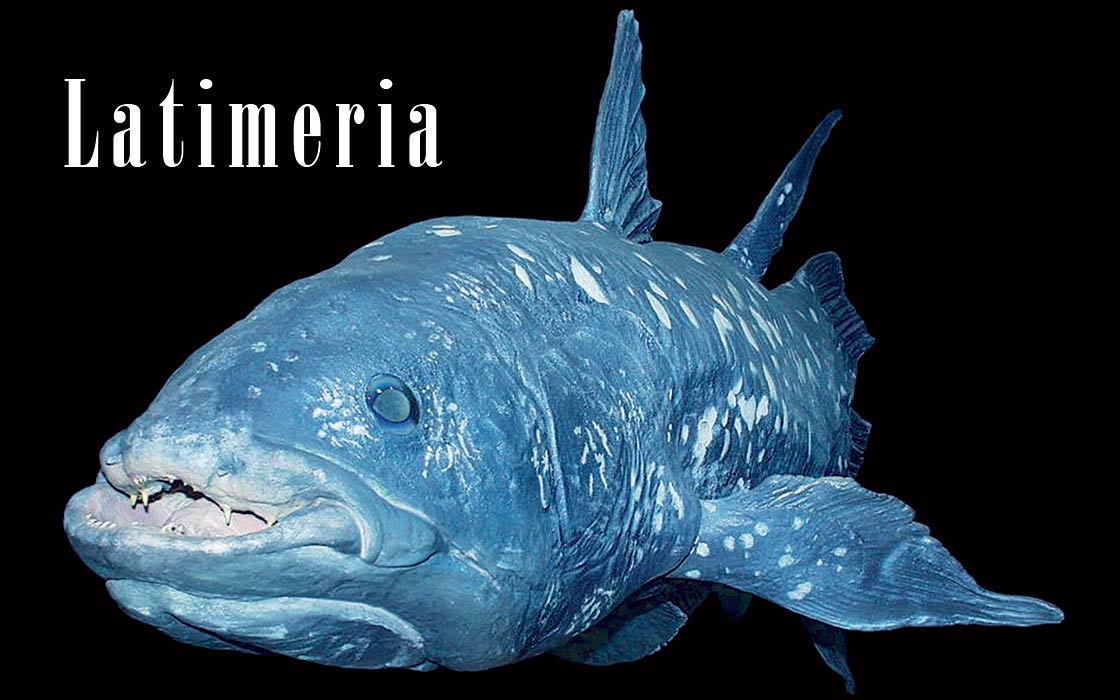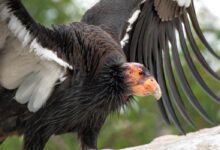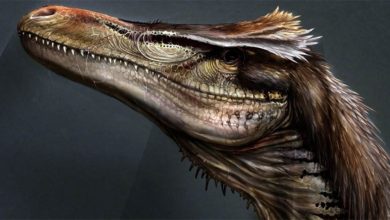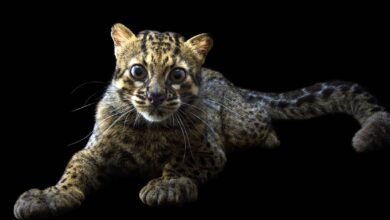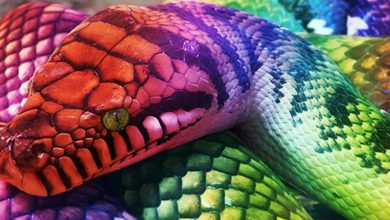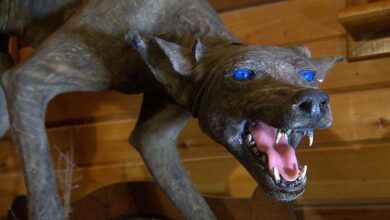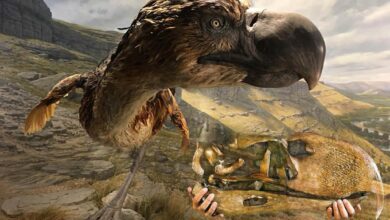Latimeria – one of the most endangered animals in the world
Latimeria – living fossil or not?
One of the oldest living animals in the world, the survival of which was hard to believe. No wonder – for centuries scientists believed that this genus died out over 60 million years ago, along with the dinosaurs. Today, Latimeria fish are still considered a rarity, which makes them almost the Holy Grail among scientists and collectors. While little is known about the lifestyle of these amazing fish, we will try to present as many facts as possible about them, hoping to satisfy the curiosity of nature lovers.
Classification
- Kingdom: Animalia
- Phylum: Chordata
- Order: Coelacanthiformes
- Family: Latimeriidae
- Genus: Latimeria
- Species:
- Latimeria chalumnae
- Latimeria menadoensis
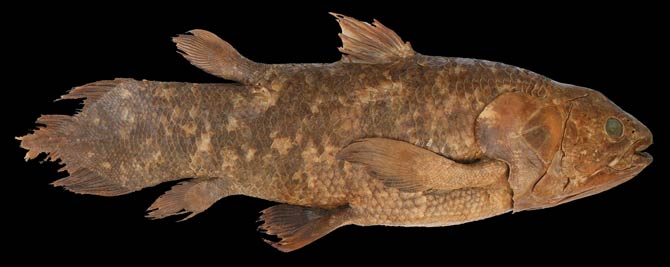
Occurrence
Today, fish of the genus Latimeria swim in the waters of southern and south-eastern Africa (the species Latimeria chalumnae), mainly in the Sodvan Bay and in the warm waters of Indonesia. They can live at a depth of 700 m (2,300 ft), but most often they stay slightly higher – 90-200 m (300 to 660 ft) below sea level. Fossil records suggest that in the Mesozoic, Latimeries occurred in all regions of the world, except Antarctica.
Latimeria dives deepest during the day to avoid too much sunlight. At night, when it goes hunting, it can appear at a depth of 17-50 m (56 – 165 ft). Water temperature is very important for Latimeria survival – it must be between 14–22 °C (57–72 °F). Under ideal conditions, the Latimeria may rise and fall alternately. However, in order to absorb enough oxygen, it must swim in cool, well-oxygenated water from time to time.
Relationship with other animals
Latimeria belong to the group of lobe-finned fishes (Sarcopterygii). This means that they are closely related to early tetrapods (Tetrapoda) and lungfish.
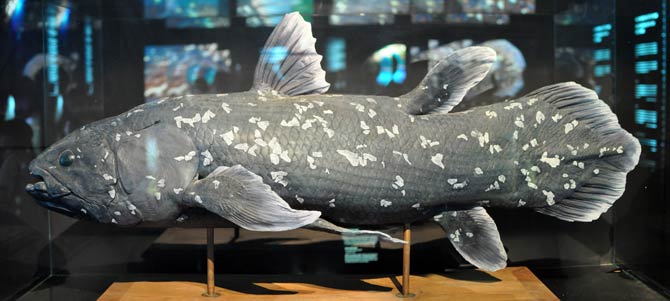
Characteristic
Appearance
A characteristic feature of Latimeria fish is the lower jaw, connected by a double joint with the skull. Thanks to this, when hunting, it can lift the upper part of its head. However, it does not have a typical upper jaw – this function is performed by strong bones of the palate with teeth.
Size
These fish reach impressive sizes – they can measure up to 2 meters in length and weigh about 90 kg (198 lb). Mostly, however, there are individuals measuring 1.2-1.5 m (3.9 – 4.9 ft), reaching a maximum of 80 kg (176 lb).
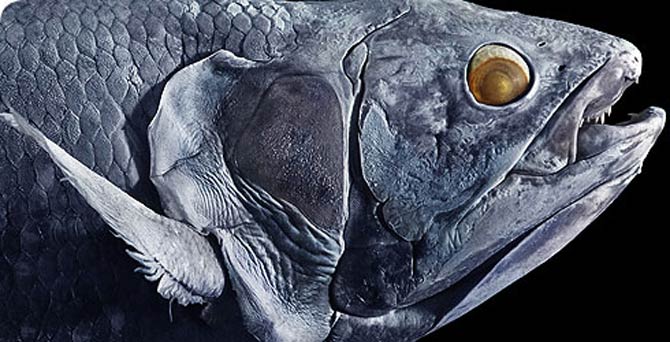
Brain
To say that Latimeria has a small brain would be an understatement. The Latimeria brain occupies only 2% of the volume of the cranial cavity. In the case of adult fish weighing several dozen kilograms, the brain (located at the back of the skull) weighs several grams (approx. 3 g (0.11oz )).
However, this is not a record, because, as we know, fish are not too intelligent animals. Let’s ignore the sharks, which have the largest brains of all fish (after all, they are predators, so they have to outsmart their prey, but for example, ocean sunfish / common mola (Mola mola), which is up to 3 meters (9.85 ft) long and weighs up to 2 tons (4,400 lb), in the case of an individual with weighing 200 kg (440 lb) has a brain the size of a peanut that weighs… approx. 4 grams (0.14oz).
Fins
The caudal fin is constructed in three parts and is additionally topped with an additional, small, soft fin. Thanks to the tail, the fish can suddenly accelerate. The paired fins (the equivalent of limbs in terrestrial vertebrates) are mounted on highly muscled, mobile shafts. The anal and hind dorsal fins are similarly constructed. The paired fins are used by the animal for rowing, therefore the fish alternately moves them during a gentle swim
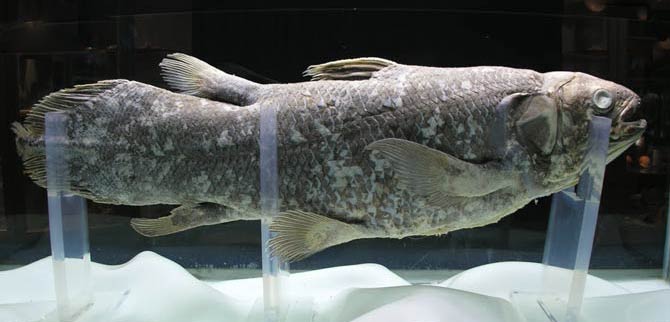
Senses
Latimeria eyes are adapted to night vision, therefore they are very sensitive to light. They can play their role thanks to the reflective film that allows you to see in dark water. In addition, at the front of the mouth, there are 3 holes leading to the so-called rostral organ in which a special substance is located. It probably allows you to sense changes in the electric field.
Primitive vertebrate
Latimeria does not have a backbone, but the so-called notochord (dorsal chord), which undoubtedly proves their primitive structure. The notochord was replaced by vertebrae in early tetrapods.
Color
The African species Latimeria chalumnae is covered in blue scales that are likely a form of camouflage. Latimeria menadoensis is brown in color. In both species, there are additionally white spots, which create a unique pattern in each individual.
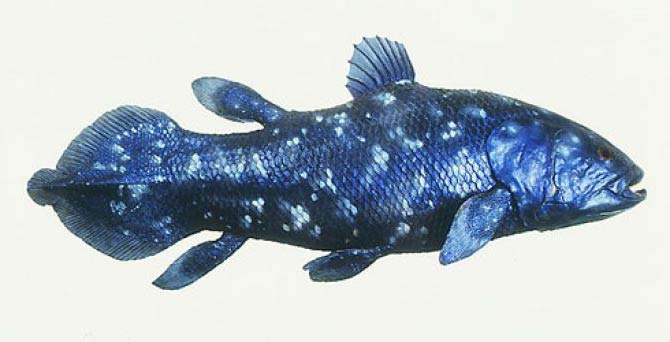
Diet
Latimeria are opportunistic predators, hunting for the easiest prey at a given moment. They mostly hunt squid, cuttlefish, snipe eels (Nemichthyidae), small sharks, and species that live in the deepest parts of reefs and on volcanic slopes.
Latimeria tracks the victim using the aforementioned rostral organ. Thanks to it, it catches changes in the electric field, caused by the presence of a potential victim. To optimize the effectiveness of this “tracking system”, Latimeria frequently changes the position of the body: it swims upside down, belly up and even backwards.
Scientists suspect that their survival skills may be associated with the possibility of slowing down metabolism. This would mean that Latimeries could go into a shallow form of hibernation, which would reduce their nutritional requirements for a time.

Reproduction
Little is known about the lifestyle of these fish. However, it has been proved that they are oviparous animals. Females can give birth to 5 to 25 young fish at a time. At birth, the little Latimeria are fully formed and self-contained.
It is difficult to say more about the reproduction of Latimeria. It is only suspected that they reach sexual maturity late – around 20 years of age. Pregnancy, on the other hand, may last 13-15 months.
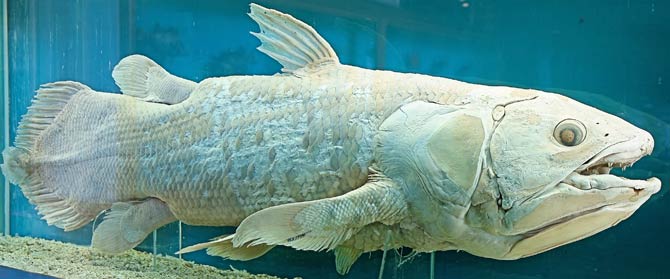
Discovery
For many years it was believed that the fish of the genus Latimeria became extinct at the same time as the dinosaurs, i.e. at the end of the Mesozoic era – about 65 million years ago. The first fossilized remains of these fish were discovered in the 19th century.
The finding was described by the Swiss zoologist and paleontologist Jean Louis Rodolphe Agassiz (May 28, 1807 – December 14, 1873). Based on the structure of the tail, ending in empty fin rays, the scientist created the name Coelacanthiformes. Nowadays this name refers to a specific group of fish, not only to Latimeria.
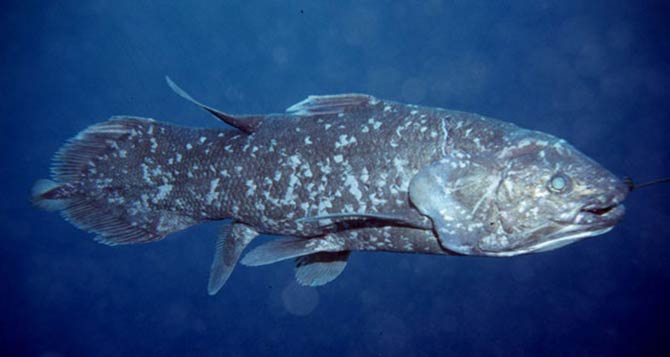
Latimeria and dinosaurs – a great surprise
In the first half of the twentieth century, and more specifically in 1938, the traveler Hendrik Goosen returned with his ship to the port of East London from a trip to the waters of South Africa. On board was an unusual blue fish he had caught, which the traveler could hardly compare to any other.
The fish was bought from him by the curator of the museum in East London – Marjorie Eileen Doris Courtenay-Latimer. The curator consulted a specialist, Professor James Leonard Brierley Smith. He stated without hesitation that it was a Celacanthiforme. He gave the find a new name – Latimeria in honor of Marjorie Eileen Doris Courtenay-Latimer. A groundbreaking discovery gave rise to the concept of a “living fossil”.
Professor Brierley Smith, viewing the sketch drawn up by Courtenay-Latimer, stated that “he would be less surprised to find a living dinosaur in the street.”

The 50s.
In the 1950s (1952), a second Latimeria (which was originally named Malania anjouanae in honor of the then Prime Minister of South Africa, Daniel François Malan) was fished out, which completely silenced the voices of skepticism.
The 80’s.
In 1988, the first photographs of Latimeria in their natural environment appeared.
90’s.
In 1991, Latimeria was identified near Mozambique and in 1995 near Madagascar.
In 1997, another remarkable discovery was made, this time in Indonesian waters. The fish resembled African Latimeria, but it differed in the brown color of the scales. Indonesian Latimeria has been classified as a separate species – Latimeria menadoensis.
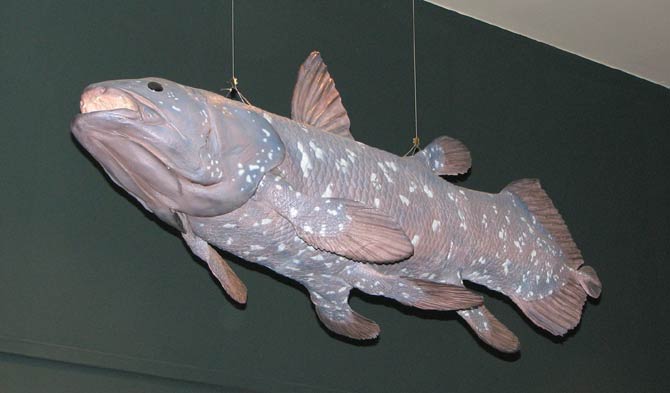
The next dates of the finds were in the years:
- 2000 – divers near the coast of South Africa
- 2001 – Kenya coast
- 2003 – 22 Latimeria were caught near the coast of Tanzania in the whole year 2003
- 2004 – the largest fish so far was caught near Madagascar
- 2007 – Latimeria caught in Indonesia survived 17 hours in the pool
Nowadays, it happens that random people catch more specimens, but the right to catch them is usually given to collectors and scientific institutions.
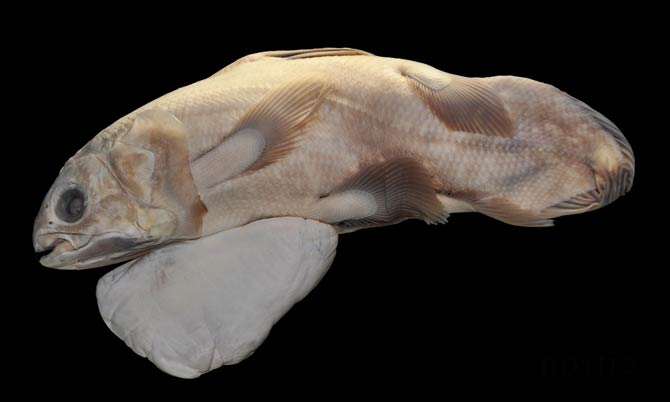
Latimeria – living fossil or not?
Research published in Molecular Biology and Evolution provides evidence that at least one species of coelacant, formerly known as Latimeria chalumnae, is not the living fossil it is believed to be. It has acquired dozens of new genes over the past 23 million years – a surprising discovery, and far from claiming that the species has changed little since its ancestors first appeared more than 300 million years ago. Moreover, this discovery is further evidence that the concept of living fossils is outdated and somewhat wrong.
Detailed information (dimensions) size
Latimeria
- Body length:
- on average: 1.2-1.8 m (3.9 – 5.9 ft)
- max. 2 m (6.5 ft)
- females are larger than males
- Weight: 80-90 kg (176 – 198 lb)
- Lifespan: probably 80-100 years
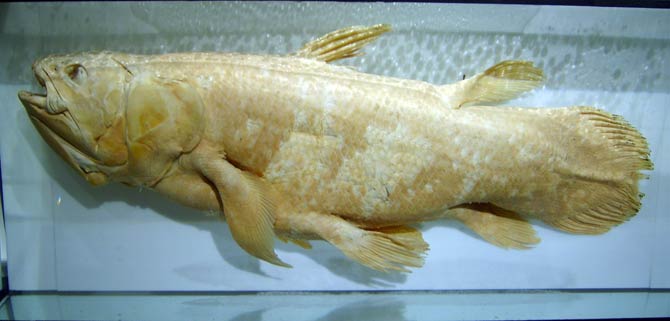
Latimeria – interesting facts
- There are only 2 (known) species of Latimeria in the world, and both are critically endangered. It is therefore the most endangered type of animal in the world.
- Latimeria is practically impossible to catch during the day. At night, however, regardless of the phase of the moon, it becomes an easier victim.
- These fish are very well adapted to the environment. This feature is recognized as one of the reasons for their very slow genome evolution. It even seems that this evolution is the slowest among all known vertebrates.
- The image of Latimeria menadoensism appeared on Indonesian postage stamps.
- The name Latimeria was given in honor of Marjorie Eileen Doris Courtenay-Latimer, curator of the East London City Museum.
- The population of Latimeria is estimated at no more than 300 individuals. Some sources estimate up to 500 individuals.
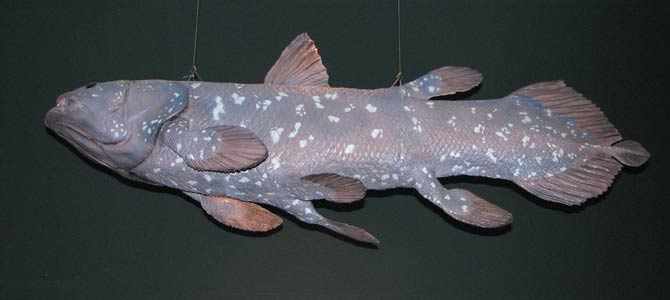
Recommended
- Megafauna
- Mammoth
- Stegodon
- Mastodon
- Platybelodon
- Indricotherium
- Cave bear
- Short-faced bear
- American lion
- European cave lion
- Smilodon – Saber-toothed tiger

